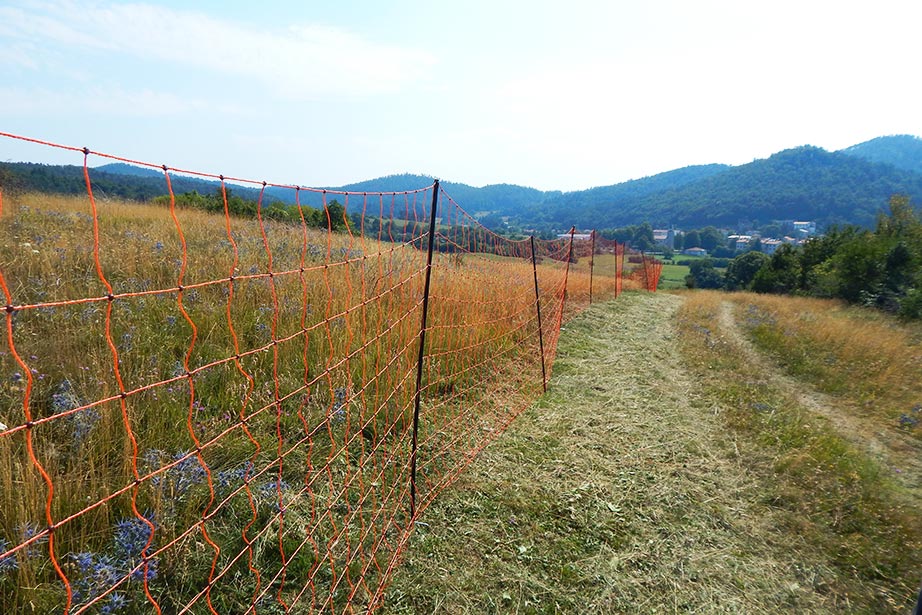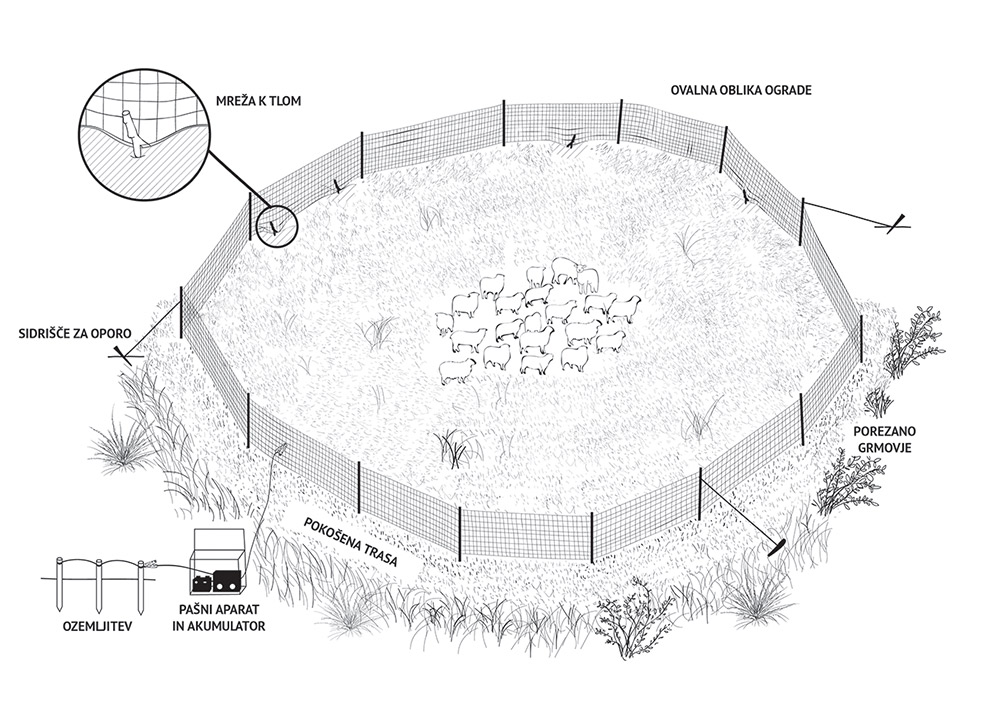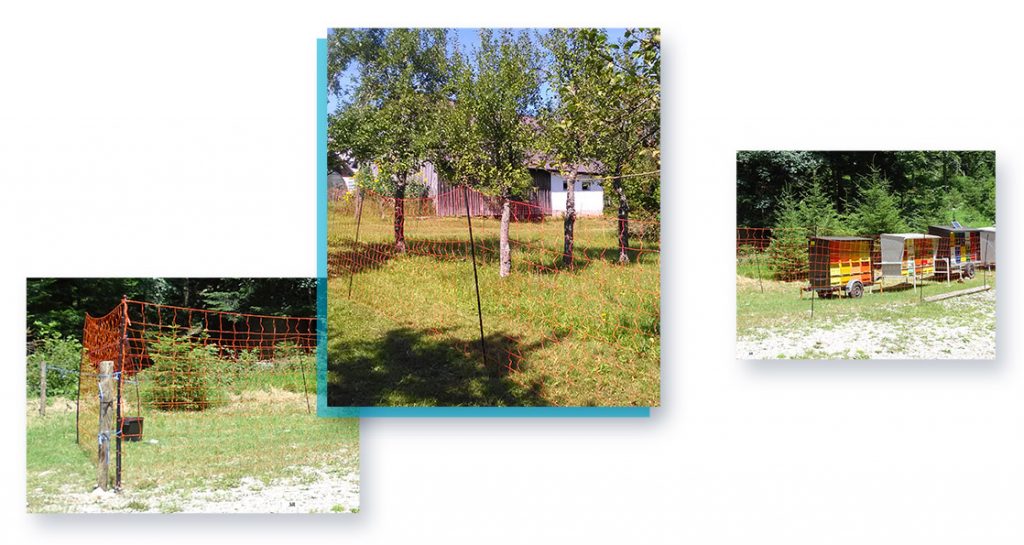High electric fences

 photo:
Enclosure of the high electric fences
photo:
Enclosure of the high electric fences
Protection with electricity
Although large carnivores are naturally very cautious animals, they can be persistent when seeking out and exploiting foods. It is generally considered that high-powered electric fences, when properly constructed and maintained, are an effective barrier to bears. Along with the associated pain of being shocked, a fence may represent psychological barrier for large carnivores like brown bears and can provide permanent protection over time.
EXPERIENCES FROM THE FIELD
Protection with high-electric fences were proven to be effective in Slovenia and in many other parts of the world where this technology is used.
ADVANTAGES
The key advantage of high electric fences is their mobility, a feature that gives an owner flexibility in terms of where to exclude bears and for how long. The mobility of transportable systems can also support improvement grazing management and can be adapted for local terrain.
Livestock can be protected on a long-term basis with electric fences and can be of particular use for smaller herd sizes when needed. High electric fences can be used also as a night enclosure. The frequency of the enclosure translocation is mainly related to the size of the herd and can be adjusted to the user’s own judgment.
DISADVANTAGES
On some stepped and rocky terrains, the installation of the high electric fence enclosure is quite challenging. Particularly translocation between various pastures requires time and some experience. In such cases, this kind of enclosure can be only one of the solutions for the herd protection in the night-time. In this case, night-time enclosure from high electric fences is placed inside a large pasture, enclosed by a multi wire electric fences, which purpose in only to keep farm animals on the pasture.
In some areas, the hiking trail leads across the pastures. In this case, high electric fences’ advantages can again be highlighted. This kind of enclosure can be installed in a way, not to hinder the passers-by.
| Advantages | Weaknesses |
|---|---|
| Effective prevention of the large carnivore damage. | Regular grass route mowing is necessary. |
| Relatively easy installation and removal, possible for translocation. | The extent of the enclosure must not exceed 500 m, as the efficiency of the electric current flow is significantly reduced. |
| Protection on daily grazing and/or as a night enclosure. | The herd must be closed in enclosure with an extent of at least 300 m; If the extent is to small, the herd does not have the possibility to flee freely when a large carnivore attack occurs. It can collapse the enclosure and thereby become an easy prey. |
| Targeted pasture, improving the grass quality, preventing excessive damage to grass and preventing parasite infections. | More frequent translocations, due to the smaller enclosed grazing area. |
| Due to the noticeable color and dense mesh, the high electric fences are much more visible, both for livestock and wildlife. | If the electric current is not constantly present in the fence, both livestock and wildlife become habituated to it. |
Components for protection with the high electric fences
Electic fences
The enclosure consists of several individual electic fences, which must be at least 160 cm high. Their extent should not be less than 300 m and not more than 500 m.
Voltage source
- To ensure a constant presence of electrical voltage (at least 5 kV) in the electric fencesk, we need a fence energizer (at least 2.5 J) supplied with:
- with a battery (at least 85 Ah and deep cycle or deep discharging batteries are recommended); or
- to a grid power (220 V).
Grounding
A key element is the fence enegrizer groudning, consisting of at least three bars or galvanized rods, with the length of at least 1 m. We ground the ground rods as deep as possible.
Additional anchorages
On the rugged terrain, we need additional anchorages to strengthen the instalation and maintain the high electric fences tensed.
Voltmeter
To check the voltage in the high electric fence.
Effective protection

Key specification of a properly installed high electric fence to enclose/protect livestock (source: handbook, pp. 10-11).
Proper use of the high electric fences for protection
- For the grounding, at least three bars or galvanized rods (1m long) should be used. Distance between rods should be at least 1 m. They should be connected with galvanized wire.
- We need to be careful about the excessive depletion of the soil. Around the grounding, the soil should be moistened regulary.
- The rugged and rocky terrain makes enclosure installation more challenging.
- The enclosure should not be placed in the nearest vicinity of overgrown areas/forest edge, which large carnivores use as a cover. This also prevents the game species from getting caught in the fence.
- The height of the high electric fences should be at least 160 cm.
- All components of the high electric fences should be tensed.
- The extent of the enclosure must not exceed 500 m, as the efficiency of the electric current conduction is significantly reduced.
- There must be no space between the lower line of the electric line and the ground, which would allow the passage.
- Wen not nedded, enclosure from high electrich fences should be removed.
- With the regular enclosure translocation, the large carnivores must experience the barrier.
- The grass route should ne mowed regulary and must not be higher than 10 cm.
You can find additional information and recommendations for the protection of other property:

If you are interested in more detailed information on this protection measure, please visit the LIFE DINALP BEAR project website.

